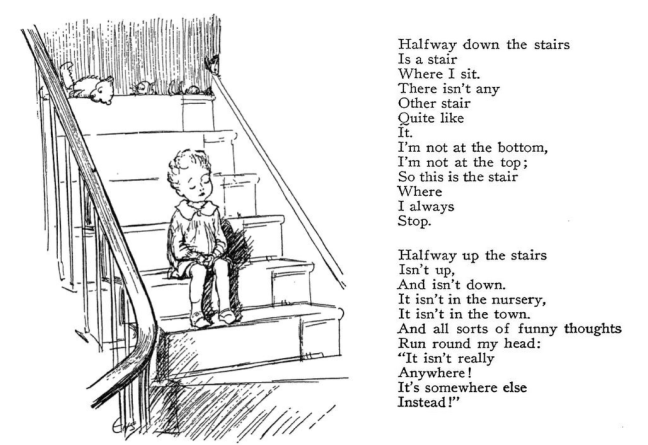Halfway down the stairs
Is a stair
Where I sit.
There isn’t any
Other stair
Quite like
It.
I’m not at the bottom,
I’m not at the top;
So this is the stair
Where
I always
Stop.
Halfway up the stairs
Isn’t up
And isn’t down.
It isn’t in the nursery,
It isn’t in the town.
And all sorts of funny thoughts
Run round my head:
“It isn’t really
Anywhere!
It’s somewhere else
Instead!”
—A.A. Milne
When We Were Very Young (affiliate link, see details)
The Stair-Counting Game
Play on any set of stairs where you won’t get in other people’s way. Start at the halfway step.
- Roll one 6-sided die. Go up that number of steps.
- Roll again. This time, go down that number of steps.
- Keep rolling the die, alternating movements up and down.
Will you ever escape the stairs?
Fill the Stairs Game
 Each player draws 11 stair steps (counting the top and bottom floors) on a piece of paper. Write zero on your middle step.
Each player draws 11 stair steps (counting the top and bottom floors) on a piece of paper. Write zero on your middle step.
Remove the face cards and jokers from a deck of playing cards. Mix the remaining cards face down in a fishing pond.
- On your turn, choose one card. Red cards are negative numbers, and black cards are positive.
- Write the number from your card on one of your stair steps.
- Then mix your card back into the pond.
- The first player to fill their stairs with numbers in order wins the game.
The numbers have to grow as you go up the stairs and get smaller going down. But you can skip numbers. For instance, you could put +2 on the stair above zero, if you like. Or you could write −4 two steps below zero, leaving only one blank in between.
If you draw a card that will not fit on your stairs, you lose that turn. Mix the card back into the pond without writing anything.
If you make a mistake — like putting +9 too close to the middle, so there’s no way to fill the higher stairs — you can use a turn to erase one number on your stairs. You don’t get to choose a new card on the same turn as erasing a number.
Fill the Stairs Variations
Help young students understand negative numbers. A stairway makes an excellent number line visual.
Download the place value version (no negative numbers) of the stairway game from Math for Love.
Or discover variations for all grade levels at Math Hombre blog. I especially like John’s Decimal Point Pickle game. And the exponential version looks like a fun challenge.
Your Turn
Do you play stairway math? Please tell us your games and variations in the comment section below.
Or share other ideas for playing math with children. I love to hear new ways to play!
* * *
This blog is reader-supported.
If you’d like to help fund the blog on an on-going basis, then please join me on Patreon for mathy inspiration, tips, and an ever-growing archive of printable activities.
If you liked this post, and want to show your one-time appreciation, the place to do that is PayPal: paypal.me/DeniseGaskinsMath. If you go that route, please include your email address in the notes section, so I can say thank you.
Which I am going to say right now. Thank you!
“Playing Math with A.A. Milne” copyright © 2020 by Denise Gaskins.

Joe Schwartz and I worked on a bunch of variations for a TMC presentation. He is a guru for using games. http://mathhombre.blogspot.com/2017/07/same-game-different-grade.html I quote the same poem! A lifelong favorite.
I love A.A. Milne! This book just entered the public domain (in the U.S.) in 2020. If I had unlimited free time, it would be fun to go through and match math activities or games to all the poems. Maybe someday…
Yes! We love A.A. Milne too 🙂 My kids played this staircase game yesterday for 30 minutes straight….and they are ages 11 and 7. It was fabulous! Thank you again!
I’m glad to hear your kids enjoyed it. Such a great game for all ages!
How about the Penrose Stairs? If you have older students or anyone interested in exploring other things, in addition to the games, it would be an opportunity to introduce the topic.
https://en.m.wikipedia.org/wiki/Penrose_stairs
How cool! I had not heard the history of those impossible stairs. I just knew of Escher’s drawing.
I taught my upper-elementary math class to draw the Penrose triangle. Maybe next time, we’ll try to work out the stairs…
I didn’t know you were drawing in the classes you teach. That’s cool!
Have you heard of the Penrose tiles? You would like that topic since I saw you had been blogging about patterns.
That was named by Roger Penrose. I’ll let you look that up
From what I read, going back to Escher, Roger Penrose’s father made the Penrose Stairs and he knew Escher.
🙂🐰Yet another rabbit trail.
Actually, I think sharing the history of math helps us learn math and discover more interesting topics in math.
Now I’m going to look for the Penrose triangle.
Thanks again.